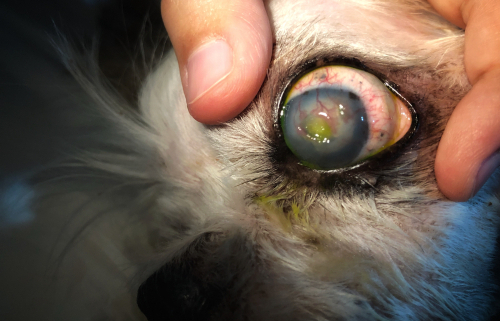Common Eye Diseases in Dogs
Diagnoses and treatment of eye disorders in dogs is known as Ophthalmology. This area of expertise is broad which means that veterinary ophthalmologists are available for referrals from your veterinarian. Keep in mind that some eye issues can be subtle in appearance, but others will cause negative changes to your dog’s vision and eyesight. This article will explain some of these diseases and when your veterinarian may need to refer your dog to an eye specialist.
It is important to know what causes eye diseases in dogs. There are several eye diseases which can be passed on from parent to puppy. Some examples of inherited eye disorders include Collie Eye Anomaly (CEA), Progressive Retinal Atrophy (PRA), and Glaucoma. Another thing to note is that dogs can develop eye infections just like humans can. These infections can be caused by parasites, bacteria, and viruses. Some of the common eye diseases in dogs are noted in our list below.
Blepharospasm – Please note that this is not an actual eye disease. However, it is important as it is one of the most common signs to indicate that your dog is having an eye problem. Dogs will normally squint the affected eye or even experience spasms of the eyelids.
Corneal Ulcers – These scratches are of the most common causes of blepharospasm in dogs. Things that cause these ulcers include allergies, smoke, infections, or irritants.
Third Eyelid Gland Prolapse – Surgery is necessary to correct this type of eye condition. The surgeon or veterinary ophthalmologist will tuck the gland back in to prevent further prolapsing. The bad thing about this condition is that if it is left untreated, the gland may stop production of sufficient tears which will result in dry eye.
Conjunctivitis – This is also known as “pink eye”. This can be caused by allergies or irritants, viral or bacterial infections, dry eye, tumors, or even eyelash disorders.
Glaucoma – Dogs with clinical signs may seem painful around their eyes, develop watery discharge, have bulging eyes, or have eyes that suddenly appear cloudy. Immediate testing and treatment are necessary because, if left untreated, glaucoma can cause permanent blindness.
It is important to understand the signs of eye disease in dogs and to address them accordingly, in a timely manner. Unfortunately, blindness is a consequence of many of the disorders which we have mentioned in this article. If you are ever in doubt, contact your veterinarian and they will provide you with a professional recommendation on how to treat your four-legged friend.



